Hackers put Kinect for Windows v2 through its paces
The Kinect for Windows team recently traveled to New York City for a terrific hackathon. In partnership with NUI Central, we had the pleasure of sponsoring a 27-hour event, June 21–22, focused on creating innovative applications and experiences using the forthcoming Kinect for Windows v2 sensor and SDK 2.0.
The event drew more than 100 participants, from as far away as the Czech Republic and Dubai. You will find a summary of the teams and projects below; we were blown away by what we saw. We were also impressed by the tremendous interest in the experimental near-field firmware that we brought. This firmware turns the Kinect for Windows v2 sensor into a near-field device that can be used at close range (from 10cm to 1m).
Lots of participants told us they wanted to get their hands on this near-field firmware. Others said how pleased they were just to have access to our engineering team. In fact, there was so much interest and energy at this event that we have set up some additional ones this summer. We would love to see you at one of our upcoming in-person events, or to have you join us online for our virtual training event on Tuesday, July 15. Please see the in-person event information below.
Upcoming in-person events
All of these events will be attended by members of the Kinect for Windows engineering team and will feature prizes, food, and, best of all, access to Kinect for Windows v2 sensors (including experimental near-field).
July 18–19, 2014: Dallas Entrepreneur Center (Dallas, TX, United States)
Computer Visionaries is hosting; we are sponsoring. It’s going to be so hot outside that you’ll want to be hunkered down inside at our event.
July 26–27, 2014: Microsoft Headquarters (Redmond, WA, United States)
This event will be here on our main campus. We will have our engineers out in full force to support this event.
August 8–10, 2014: Kitchener Studio Space (Kitchener, ON, Canada)
We are sponsoring Deep Realities and hosting a weekend hackathon in the Waterloo Region.
New York City hackathon summary
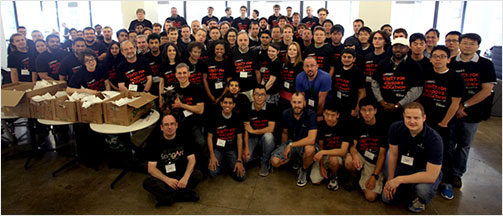
New York City hackathon participants
As noted earlier, this event was hosted by our partner, NUI Central, in Manhattan (New York). The top three teams were:
First place: lightspeed. Their application, called K4B, used a Kinect for Windows v2 sensor to scan large ceiling spaces in order to map HVAC and electrical details so that renovators can get accurate, detailed as-built measurements.
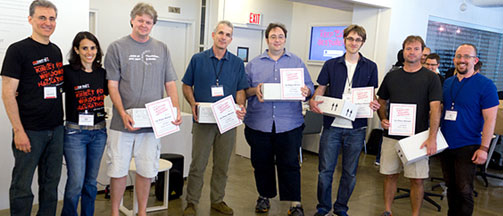
First-place winners, team lightspeed
Second place: adabiits. Their application, Thing T. Thing, included a robotic hand that waves when someone walks by and can be controlled by using finger tracking.
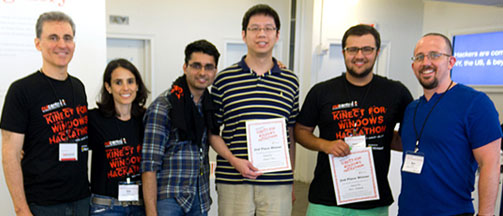
Second-place winners, team adabiits
Third place: Body Labs. Their application, ScanAdHoc, combined multiple Kinect for Windows v2 sensors wirelessly over WebSockets, enabling accurate 3D body scans to be used for fitting clothes.
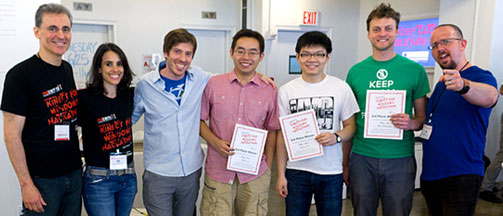
Third-place winners, Body Labs
Other teams that presented projects:
- Augmented Travel presented “Augmented Travel,” which allows you to explore an area virtually, by using your body as the controller.
- Cornell Tech presented “Body DJ,” which enables you to “rock out” by using body gestures.
- Critical Mass presented “Sweeper,” which uses Kinect Ripple to raise awareness about the deadly nature of landmines. The team posted a video.
- Gunters presented “Blox,” which combines the v2 sensor and Oculus Rift to create a personal world using drag and drop.
- Landroids presented “Obstacle Avoidance Robot,” which used Kinect for Window’s depth sensing capabilities to aid navigation for a Lego Mindstorm robot.
- Leftover presented “Touchless Controller,” which enables you to use gestures to control any Windows application or to scroll and navigate in a web browser or Visual Studio.
- Sandwich Dance Party presented “Hue Light Controller,” which enables you to point at a physical light in the room to turn it on or off, and then to use a hand gesture to change the color of the light.
- SLIP SLAP presented “Around the Cluck,” a game about gold and a guardian chicken, created in Unity 3D. Players must move around the room and carefully collect eggs, so as not to awaken the chicken.
- SoundPound presented “SoundPound,” a human drum that functions as roadside sobriety test.
- SpiceDoctor presented “Kinect Virtual Doctor,” a Windows 8 application that uses the Kinect for Windows v2 sensor to monitor your heart rate in real time.
- Team Fantabulous presented “Power Doge,” a cutting-edge media browser in which novel hand gestures create a unique photo viewing experience.
- Trail Makers presented “Immersive Trail,” a twenty-first–century approach to the Trail Making Test, a neuro-psychological assessment of visual attention and the ability to switch tasks.
- Tropicana Pure Premium presented “Finger Tracking Keyboard,” which enables you to shift keys by moving your hand.
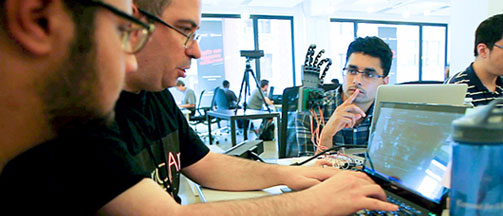
Kinect for Windows MVP András Velvárt helps team adabiits.
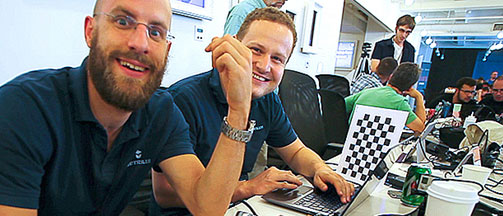
Hannes Hofman and Chris Schaller from Metrilus brought their finger-tracking library to the event.
Congratulations to all the participants, whose creativity highlighted the immense possibilities in the Kinect for Windows v2 sensor and SDK. If you haven’t pre-ordered the v2 sensor yet, there is still time, but don’t wait too long.
Ben Lower, Kinect for Windows developer community manager
Contact Ben on Twitter at @benlower
Key links
- Learn more about Kinect for Windows
- Join us for the July 15 virtual training event
- Register for the July 18–19 Dallas event
- Register for the July 26–27 Redmond event
- Register for the August 8–10 Kitchener event
- Pre-order the v2 sensor
- See Kinect for Windows applications in action
- Follow us on Facebook and Twitter